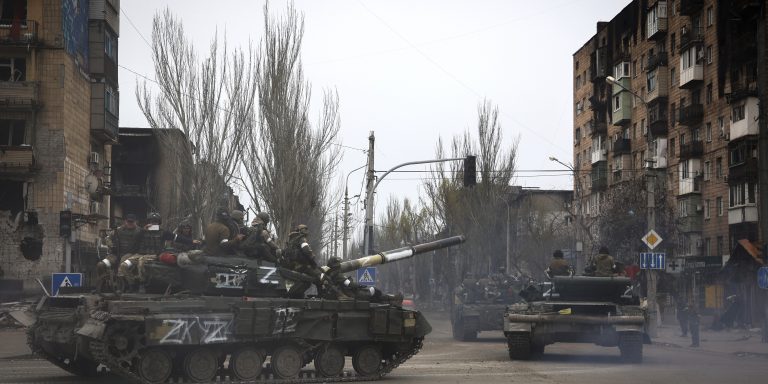INTELBRIEF
April 25, 2022
IntelBrief: Russia Recycles Disinformation Playbook in Ukraine During Assault on Mariupol

Bottom Line Up Front
- Russia continues to wage a disinformation campaign about its actions in Ukraine, working to sow false narratives about the conflict in general, but also about atrocities committed by Russian forces against civilians.
- From April 8 to 14, online chatter about foreigners fighting for Ukraine rose in prevalence among key themes monitored and analyzed as coming from likely Russia-backed or aligned actors online.
- Certain disinformation narratives are particularly concerning, as they could be used by Russia as a pretext to target NATO allies in Europe.
- Western countries should prioritize pre-bunking and de-bunking Russian disinformation in order to discredit these narratives before they have an opportunity to go viral and resonate with the Kremlin’s target audiences.
As another ploy in the Russian disinformation machine focused on the war in Ukraine, new false narratives have been seeded recently to sow confusion and distrust about foreign volunteers supporting Ukraine’s defense. On April 4, The Soufan Center released a Special Report detailing the complexities and range of non-state actors—mercenaries, foreign fighters, and volunteers—flocking to fight on both sides of the conflict in Ukraine. The report also detailed Russia’s utilization of disinformation to further advance its interests in Ukraine and beyond. While Russia declared on April 21 that Mariupol had been “liberated,” the U.S. Department of State deemed this as disinformation, asserting that “Ukrainian forces continue to hold their ground” at Azovstal steelworks in the city. This is only one of the disinformation narratives Russia has been peddling in recent weeks about its assault on Mariupol, among others that deflect from or re-orienting blame of likely war crimes perpetrated by Russia. A particularly worrisome Russian disinformation narrative has been proliferating online over the past weeks spreading false rumors and claims about Western volunteers allegedly captured by Russian forces, often labeling them as “mercenaries” and claiming that they are evidence of NATO’s “direct” involvement in the war.
During April 8 to 14, online chatter about foreigners fighting for Ukraine rose in prevalence among key themes monitored and analyzed as coming from likely Russia-backed or aligned actors online. The increase in chatter was likely prompted by reports of European nationals fighting for Ukraine being captured or killed by Russian forces, primarily in Mariupol but also in other areas in Ukraine. According to our analysis, over 50% of all artifacts peddling such narratives that week came from likely foreign actors, primarily Russia. This is on par with the level of foreign influence common in know Russia-backed or aligned disinformation narratives and themes centered on the war in Ukraine, including the “Secret U.S. biolabs” conspiracy theory and the “denazification” disinformation narrative. Many of these false narratives have been parroted and amplified by actors likely connected to the Chinese Communist Party (CCP).
Qualitative research demonstrates that many of these reports about killed or captured foreign nationals circulating online—which included videos and photos—were peddling disinformation narratives, including that the presence of Westerners joining Ukrainian forces is evidence of the West supporting “Ukrainian Nazis” and that NATO is now “directly” involved in the conflict. This is used to convince Russia’s domestic population of the rationale for the war, but these false narratives have also gained traction overseas, including throughout the Middle East and Africa. There was also an observed concerted effort online to attempt to label the foreign nationals as “mercenaries” of the West. While there are reports of European and American nationals traveling to Ukraine to volunteer in the armed forces, some other foreigners have been fighting for Ukraine since Russia’s 2014 invasion—some of whom hold dual citizenship—and are currently in Mariupol. The lion’s share of foreigners fighting for Ukraine, in any case, are from the immediate region. Moreover, there exists no evidence that these individuals have been sent to fight in Ukraine at the behest of NATO. This disinformation narrative is assessed as particularly concerning, since it could be used as a justification by Russia to target NATO allies in Europe at some stage.
Using captured foreigners for propaganda and disinformation purposes is a playbook Russia has employed in other conflicts, including Syria and Libya, to discredit the United States and its allies. However, the presence of foreigners and non-state actors on both the pro-Russian and pro-Ukrainian side of the war further complicates the on-the-ground dynamics, prompting the need for close monitoring by the U.S. and European governments. Furthermore, it is likely that Russia will continue to use captured Western volunteers fighting on the Ukrainian side for propaganda and disinformation purposes to denigrate the West. While these narratives are pushed online, they have real-world consequences. Accordingly, the United States and European allies should work on pre-bunking and de-bunking Russian disinformation in order to discredit these narratives before they have an opportunity to go viral and resonate with various target audiences Moscow seeks to influence.